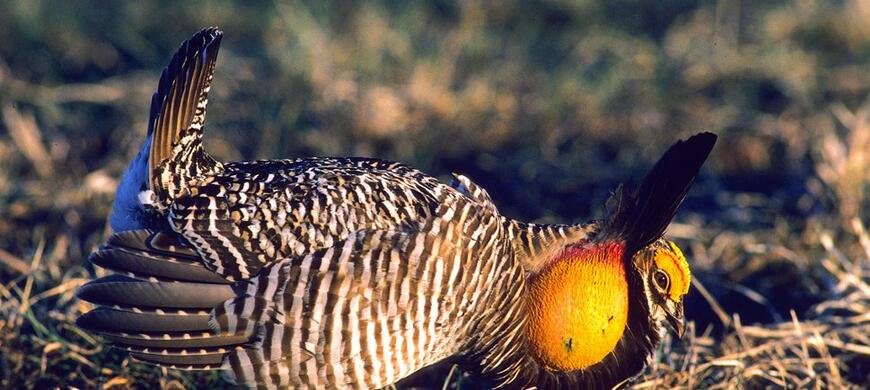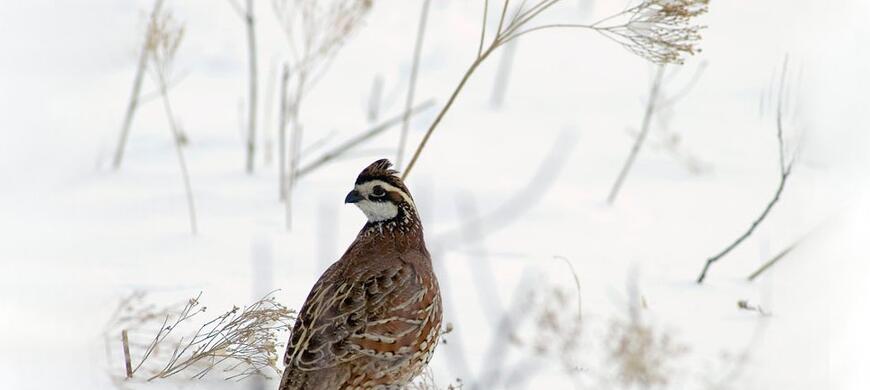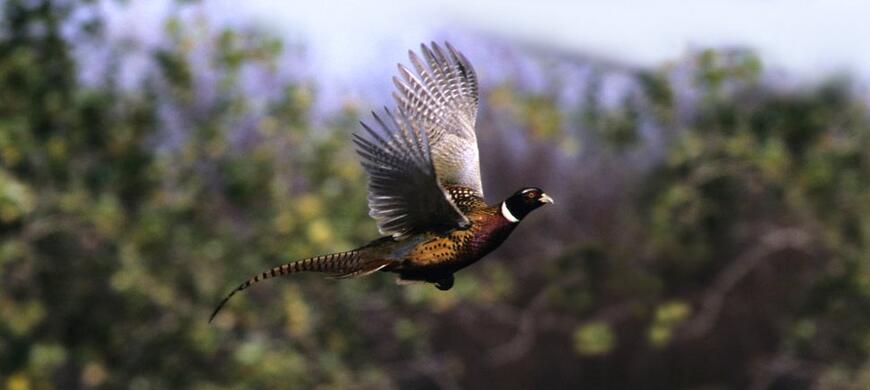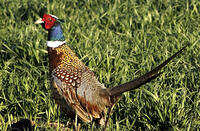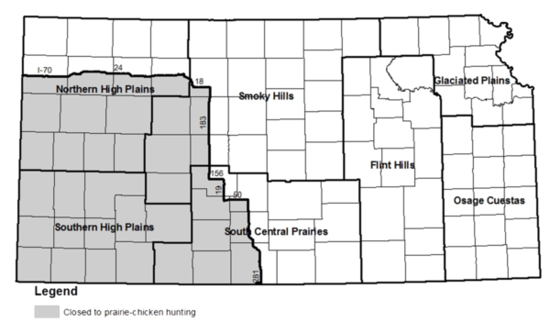Upland Birds
Kansas boasts some of the best upland bird populations in the world. In fact, the largest concentrations of both lesser and greater prairie chickens are found in Kansas. Bobwhite quail still thrive throughout much of the state, and in the far southwest corner, scaled quail can be found. Although not native, the ring-necked pheasant has become a fixture to much of the Kansas landscape. This variety and abundance of opportunities has made Kansas one of the more popular destinations among bird hunters worldwide. All upland bird populations fluctuate annually according to weather and habitat conditions. To assist hunters with travel plans, KDWPT staff use a variety of surveys to assemble the Upland Bird Forecast, which is published each September. The forecast provides up-to-date information about bird numbers around the state.
Two important factors impact availability of upland game during the fall hunting seasons: number of breeding adults in the spring and the reproductive success of the breeding population. Reproductive success consists of both the number of hatched nests and chick survival. For pheasants and quail, annual survival is relatively low; therefore, the fall population is more dependent on summer reproduction than spring adult numbers. For prairie chickens, reproductive success is still the major population regulator, but higher adult survival helps maintain hunting opportunities during poor conditions. In this forecast, breeding population and reproductive success of pheasants, quail, and prairie chickens will be discussed. Breeding population data were gathered using spring calling surveys for pheasants, quail, and prairie chickens. Data for reproductive success were collected during late-summer roadside surveys for pheasants and quail, which quantify both adults and chicks observed. Reproductive success of prairie chickens cannot be easily assessed using the same methods because they do not associate with roads like pheasants and quail.
Kansas has a dramatic rainfall gradient of more than 50 inches of average annual rainfall in the far east to less than 16 inches in the far west. The amount and timing of rainfall plays a major role in reproduction for upland birds. In the west, wet years typically improve the available cover and increase insect availability for chicks. In the east, dry years are typically more optimal, as heavy rains during spring and summer can reduce survival of nesting birds and young chicks. In 2023, much of western Kansas received above average rainfall during the summer months. This created high quality brooding cover; however, because it followed intense drought, nesting cover was limited. As a result, brood survival was high where chicks were hatched but overall production was low due to poor nesting conditions.
Pheasant – Intense drought conditions throughout 2022 reduced pheasant populations and the available nesting cover for 2023. Precipitation across most of the primary range this summer greatly improved habitat conditions for chicks. This should have improved the survival of broods that were hatched and could result in some localized improvements where nesting cover was maintained. However, lack of nesting cover and low populations across most of the state prevented any major improvements in densities this summer. The High Plains region of the western third of the state saw some areas of improvement but remain low after sharp declines in 2022. The North Central Smoky Hills region remained good last year in spite of the drought but dropped to levels similar to the remaining pheasant regions. The statewide pheasant index is similar to our previous drought cycle. Recovery from these declines will likely take longer as habitat has declined with the declines in CRP enrollment (again this year, acres enrolled in CRP were released to be used for emergency forage for cattle across most of the state). This will likely impact hunter success in 2023 as well as the amount of nesting cover for pheasants again next year. While hunting opportunities still exist where habitat was maintained, hunters will find challenging conditions and should be prepared to work for birds.
Quail – Kansas has continued to support above-average quail populations with spring densities similar to last year; This included significant increases in portions of the western regions of the state this spring. The peak nesting for quail is later than pheasants. And quail have a longer nesting season allowing them to take advantage of quickly-changing conditions. Rains beginning in early summer and continuing through much of the nesting season greatly improved habitat conditions across the state. Given the high spring densities and improved summer conditions, staff expected to see increased production on the brood surveys this year. Despite these conditions, brood detections were decreased. This may be attributed, in part, by the abundant habitat available during the survey. Kansas maintains one of the strongest quail populations in the country and, given our abundant access, harvest will again be among the highest in the country. The best opportunities will be in the central regions of the state into the Flint Hills, with quality hunting opportunity scattered throughout the remaining regions.
Prairie Chicken – Kansas is home to both greater and lesser prairie chickens. Both species require a landscape of predominately native grass and benefit from a few interspersed grain fields. Greater prairie chickens are found primarily in the tallgrass and mixed-grass prairies that occur in the eastern third and northern half of the state. Greater prairie chickens have recently expanded in numbers and range in the Northwestern portion of the state while declining in the eastern regions. Drought conditions are likely to have impacted production some, but prairie chickens are typically less volatile than other upland bird species and production is harder to estimate. Hunting opportunities will be best in the Smoky Hills Regions this fall where populations have been stable and public access is more abundant.
The Southwest Prairie Chicken Unit, where lesser prairie chickens are found, is closed to hunting. Greater prairie chickens may be harvested with a two bird daily bag limit in the Greater Prairie Chicken Unit. All prairie chicken hunters are required to have a Prairie Chicken Permit, which allows KDWP to better track hunter activity and harvest to inform management.
Public Land: 12,849 acres
WIHA: 369,016 acres
Pheasants – This region saw improvements on the roadside survey this year. While many routes had big improvements, they were also starting very low after limited production last year. Hunters should find some success in areas where nesting cover was maintained last year. Keying in on available food might be more important this year, as late heat waves caused some grain crops to fail. The highest densities will be found in the western counties of the region where densities were greatest last year.
Quail – Quail are limited and are typically harvested opportunistically by pheasant hunters. In recent years, weather patterns have facilitated a population expansion into areas where appropriate habitat exists, providing hunters with a welcomed additional opportunity. Densities on the summer roadside survey decreased this year. Opportunity will remain best in the eastern most counties of the region.
Prairie Chickens – Prairie chicken populations have expanded in both numbers and range within the region. Only portions of this region are open to hunting (see map for unit boundaries). Based on other upland bird production, staff estimate production in the region was likely poor this year, as well. Within the open area, the best hunting opportunities will be found in the northeastern portion of the region in native prairies and adjacent CRP grasslands.
Public Land: 106,558 acres
WIHA: 298,826 acres
Pheasants – While this region showed a decrease on the roadside survey, this area maintained the highest regional roadside density this year. Smoky Hills will again be a major contributor to the overall harvest this year in Kansas. Late rain greatly improved habitat conditions, though this took place after the primary nesting season. This has the potential to spread remaining pheasants throughout more abundant cover. Overall, the northcentral portions of this region had the highest roadside densities this year.
Quail – This region has enjoyed several years of well above average quail densities. Results from the spring whistle survey remained stable this year, maintaining the above average spring densities. However, brood survey estimates saw significant declines. Given decreases seen in the brood survey, hunter success rates are expected to decrease this year. The caveat to this is hunter success could be higher than expected given abundant habitat in rangeland that is difficult to sample. Densities appear best in the northcentral part of the region, but several other areas across the region maintained good estimates, as well.
Prairie Chickens – Prairie chicken hunting opportunities in this region should remain good. Production was likely improved as other upland birds supported greater production in the Smoky Hills. This region has maintained relatively stable densities paired with the greatest access to appropriate habitat in the state. Greater prairie chickens occur throughout this region where large areas of native rangeland are intermixed with cropland. The best hunting will be found in the central portion of this region, but several other areas support huntable densities of birds in appropriate habitat. Note: The southwestern portion of this region is within the closed zone (see map for unit boundaries).
Public Land: 51,469 acres
WIHA: 70,065 acres
Pheasants – Opportunities will likely remain poor in this region, with pheasants occurring only in pockets of habitat, primarily in the northwestern portion of the region or in areas managed for upland birds. Pheasants were only recorded on one route this year. Pheasant densities across this region are typically low, especially relative to other areas in central and western Kansas.
Quail – After increases last year (last season was above average densities for the region), the summer roadside survey showed declined improvements for 2023. While densities decreased, they will still be above average for the area. With the limited amount of nesting and roosting cover throughout much of this region, targeting areas with or near native grass will be key for success.
Prairie Chickens – Very little prairie chicken range occurs in this region and opportunities are limited. Opportunities for encounters will be highest in the western edges of this region, along the Flint Hills where some large areas of native rangeland still exists.
Public Land: 109,883 acres
WIHA: 33,937 acres
Pheasants – This region is outside the primary pheasant range, therefore very limited hunting opportunity is available. Pheasants are occasionally found in the northwestern portion of the region, though at very low densities.
Quail – This year, opportunities for quail will be poor in this region. While roadside estimates trended up again this year, results were greatly influenced by a few counts with most of the region remaining low. Modest improvements have still not recovered the region from several consecutive years of poor production. While hunting could be slightly improved in 2023, the best opportunities will be on areas specifically managed for upland birds and the western counties in grasslands extending east off of the Flint Hills.
Prairie Chickens – Greater prairie chicken populations have consistently declined over the long term in this region. And, fire suppression and loss of native grassland has gradually reduced the amount of suitable habitat. Hunting opportunities will be limited, but chickens can occasionally be found in large blocks of native rangeland, primarily along the edge of the Flint Hills.
Public Land: 196,901 acres
WIHA: 86,326 acres
Pheasants – This region, located on the eastern edge of the primary pheasant range in Kansas, offers limited opportunities. Pheasant densities have always been low in the Flint Hills, with the highest densities on the western edge of the region. And though the roadside index increased this year in this region, results were primarily influenced by large increases on an individual route. Given the limited nature of this increase, it is unlikely hunters will see much change in pheasants across this region in 2023. The best opportunities will be in the northwest portion of the region along the Smoky Hills.
Quail – This region had the highest regional spring whistle index this year. Though, estimates on the summer brood survey declined after the region remained in more critical drought stages compared to other regions. Given high spring densities, the region should maintain reasonable hunting opportunities this fall. Quail production can be impacted in the core of the Flint Hills with annual burning practices limiting nesting cover. Hunters will find the best success in areas that maintained nearby nesting cover and have retained shrub cover that has otherwise been removed from large areas of the region during invasive species control efforts. The highest densities will be found in the southern half of the region this year.
Prairie Chickens – The Flint Hills is the largest intact tallgrass prairie in North America and has been a core habitat for greater prairie chickens for many years. Management changes resulting in both areas of too little and too much prescribed fire have gradually degraded habitat quality, and prairie chicken numbers have declined as a result. Burning was near average in 2023, limiting nesting cover in the core of the Flint Hills. Hunting oppo
Public Land: 41,125 acres
WIHA: 68,510 acres
Pheasants – Roadside survey estimates were similar to last year. There were a few routes that maintained relatively good densities within the region. While roadside estimates are lower than the other major pheasant regions last year, this region boasted the highest hunter success rates. The highest pheasant densities will be found in the Northwestcentral portion of the region this year.
Quail – This region had the highest regional index during the brood survey after ample summer rainfall. The counties dominated by the Red Hills prairie saw great improvements. Compared to other regions, the intermixing of quality cover types in this region provide more consistent opportunities. Other areas within the region boasting good native grass are also likely to see improvements.
Prairie Chickens – The large rangeland areas in this region are almost entirely closed to prairie chicken hunting (see map for unit boundaries). Prairie chickens occur in very limited areas in the remainder of this region at very low densities. Encounters are possible in the few remaining large tracts of rangeland in the northeastern portion of the region.
Public Land: 116,821 acres
WIHA: 144,067 acres
Pheasants – After declines last year, summer brood survey results remained similar this year. Drought impacts were the worst in this area where average rainfall was lower than other regions. Habitat conditions are greatly improved and will likely spread out the remaining birds. Note: Much of this region was released for emergency CRP use again this year, which will likely impact some of the huntable cover.
Quail – Though the quail population in this region is highly variable and dependent on weather, the roadside estimates were improved in this region with the improved habitat conditions. The highest densities in this region are found along riparian corridors or where adequate woody structure exists. This association with riparian corridors makes surveying the region for an accurate density of quail challenging, and opportunities can be better than roadside surveys suggest at times. Scaled quail can also be found in this region within the sand sage prairies but make up a small proportion of total quail.
Prairie Chickens – Prairie chicken hunting is closed in this area.
Conservation Reserve Program
Under the 2018 Farm Bill, the Conservation Reserve Program (CRP) acreage cap has gradually increased each year. Currently, Kansas has 1.8 million acres of CRP. However, more than 300,000 acres of this is grassland CRP; and traditional CRP acres continue to decline. Lower interest is currently attributed to reduced rental rates combined with high commodity prices. In addition to loss of acres, the quality of habitat on the remaining acres will be reduced. A total of 102 Kansas counties were released for emergency Haying and Grazing of CRP. A large portion of properties in Kansas’ Walk-in Hunting Access (WIHA) and iWIHA program include CRP and expirations/haying can reduce habitat quality or exclude properties from the program. Kansas’ WIHA/iWIHA program has nearly 1.07 million acres enrolled for 2023 (atlases are available online at ksoutdoors.com/wiha and where Kansas hunting and fishing licenses are sold).
Kansas has almost 1.7 million acres open to public hunting (Wildlife Areas and WIHA combined). There are more than 50 million acres of private land that also provide opportunity where permission can be obtained.











